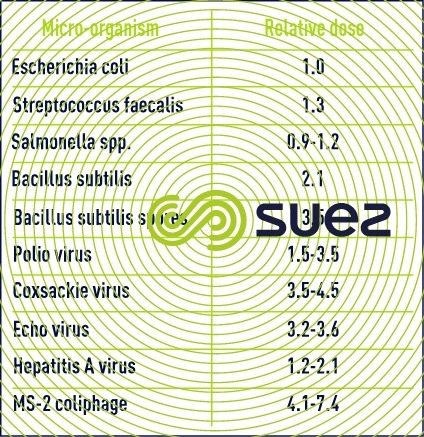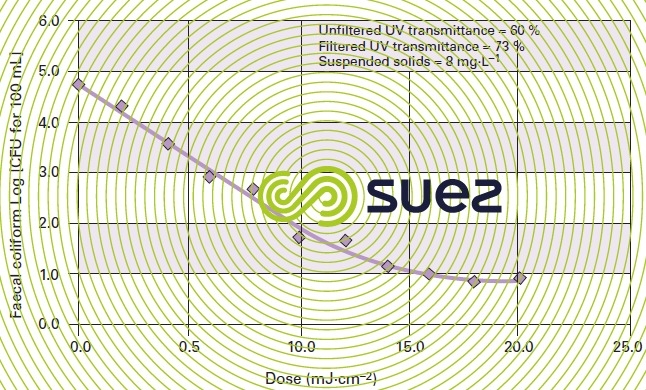basic principles – terminology
Reading time:terminology
Inactivation: difference between the number of micro-organisms present before and after disinfection. Abatement is usually expressed in common logarithms.
Ballast : electromagnetic and/or electronic component used to initiate and control the operation of a discharge lamp.
Bioassay: disinfection test used to validate the performance of a UV disinfection system (on a reduced or industrial scale). The Bioassay uses spiking procedures with a target micro-organisms injected upstream of the disinfection system.
UVC dose (in mJ · cm–2): the UVC energy used or to be used in order to obtain a given inactivation for a given micro-organism. The UVC dose is the product of the UVC flux with the contact or exposure time.
UVC flux (in W · cm–2): radiation power received by an infinitesimal sphere. In UV reactors, UVC irradiance and flux are often interchanged.
Quartz sleeve: sleeve protecting the UV lamp from direct contact with water; this sleeve is permeable to UV radiation.
UVC irradiance (in W · cm–2): radiation power received by an infinitesimal surface area. The term “intensity” is also frequently used.
Module: an element consisting of several ultraviolet lamps laid out in a redundant pattern and mounted under the same frame. Each module has its own electrical power supply.
Row of modules: a series of modules set across the entire width of a UV channel.
UV radiation: electromagnetic radiation ranging from 100 to 400 nm.
UVC radiation: electromagnetic radiation of between 200 and 280 nm and used in germicidal applications.
Closed reactor: tubular shaped UV reactor that can operate under pressure.
Open reactor:UV reactor installed in an open channel with steady level.
UVC transmittance (as a %): ratio between transmitted irradiance and incident irradiance through a water layer (1 or 5 cm). In wastewater, this parameter should be measured on a sample that is filtered (filtered transmittance) and on an unfiltered (non-filtered transmittance) Care must be taken to ensure that samples are representative of the period concerned (day, month).
UV action on DNA and RNA
Nucleic acids, deoxyribonucleic acid (DNA) or ribonucleic acid (RNA) are vital building blocks in the reproductive system of all micro-organisms. As already seen in the oxidants and disinfectants section, the nucleotides that make up DNA and RNA strongly absorb UV radiation in the 220 to 290 nm spectrum with a peak at 260 nm. From this radiation absorption damages result that stops the cell reproduction process. Irradiated cells continue to live for a while but cannot reproduce and therefore contaminate a host.
doses required
The design dose is based on a target micro-organism(s) and disinfection objective (inactivation or maximum microbial count in the effluent). This dose can be established by means of a data base created from experience or especially in the case of wastewater by means of an inactivation test conducted with a collimator on the effluent to be disinfected (see the bioassay (biological test)).
design dose based on the target micro-organis
For a given level of ainactivation the design dose varies versus the type of target micro-organism. In the laboratory, it is easy to plot UV inactivation curves for certain type of micro-organisms such as Escherichia coli, fecal coliform, total coliform or MS2 (figure 33). On the other hand, the UV sensitivity of other microorganisms is far more difficult to establish such as that of salmonellae, polio virus and hepatitis virus. Therefore, in most cases a relative dose comparison table is used to determine the design doses applicable to certain micro-organisms. Table 13 provides the commonly accepted ratios.



design dose based on a maximum effluent count
The more stringent the treatment objective the higher the required dose is. The relationship of dose versus effluent count is not linear for wastewaters due to the presence of suspended solids that shield or even encapsulate micro-organisms (figure 32). The greater the number and size of suspended solids the more difficult it is to satisfy stringent disinfection objectives (type "Title 22" taken from Californian regulations).



design dose based on a target inactivation (n log abatement)
Using the target micro-organism inactivation curves, the dose that matches the target inactivation is applied. For wastewater applications that include the presence of suspended solids it is critical to check that the target inactivation is achievable.
Bookmark tool
Click on the bookmark tool, highlight the last read paragraph to continue your reading later












